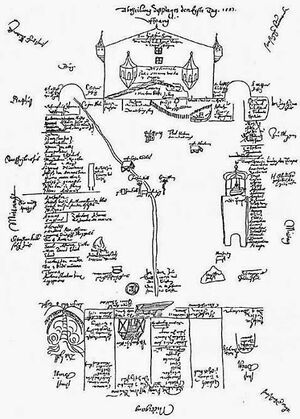Theatre in the market-place[edit]
In the Middle Ages, theatre performance, like the churches, was located in urban space: in squares and streets. Here, mystery plays were performed, such as in Lucerne, and in the square in front of the Palais d'Arshot in Valenciennes in 1547.
An illustration by Hubert Cailleau shows the stage design for The Passion and Resurrection of the Saviour. This dramatic performance representing Christ’s Passion from the Last Supper to the Crucifixion took place in 1547 and lasted 25 days. Although from the Renaissance period, the painting shows it to be one of the best examples of the theatrical place of the Middle Ages.

The text of the Passion of Valenciennes has fifty thousand verses and narrates two cycles: the Annunciation-Incarnation-Nativity and the Passion-Death-Resurrection, superimposing different stories with diverse places: Paradise, Hell, Nazareth, Capernaum, Lake Tiberias, Egypt, Rome, the kingdoms of the Three Kings and the sea. These places are housed in mansions, little stages, which represent them figuratively. They are able to change and look like a pavilion or palace, with a colonnaded portico standing on a raised podium. At either end there are two fixed mansions. On the left, the paradise, a small temple with God contemplating on a throne surrounded by a choir of angels. On the right is the hellmouth (Q30601), represented by a flaming castle in which human figures are enclosed and suffer atrocious tortures and burn, consumed by eternal fire, surrounded by dragons and demons. Mechanisms were created so that characters, such as angels, could fly; clouds and sky cloths concealed the pulley system. Trap doors were used for quick appearances and exits, also red paint as blood and other special effects.
The text presents the whole world and the afterlife in one space. In a way, Valenciennes' podium is a continuation of the skene of classical Greek theatre, but the unity of the stage front has been broken down. Even so, during the play, the audience had to move from one mansion to another and saw the performance from three sides of the stage.
The German-language Mystery play of Lucerne, Switzerland took place from the early fifteenth century into the late seventeenth century in intervals of twenty years. Many documents survive, like the stage layout with about seventy places, an actor's contract, an account of receipts and costs, the names and roles of most participants, and the script. Strict rules required actors to:
- accept the roles assigned, and provide their own costumes unless they differed from their ordinary clothing. The majority were merchants and the working class, mostly men and boys.
- agree not to meddle in the affairs of the supervisory committee and not to grumble against decisions. There was a schedule of fines, if they were late, drunk, or missed lines, and a list of missing rehearsals (the only excuse allowed was illness)
- contribute to the finances. The amount varied based on the importance of the role. The council paid for a lot of the expenses, such as banquets after performances, but actors were asked to chip in.
A painting by Jean Fouquet, The Martyrdom of Saint Apollonia from the mid-15th century, has allows us to understand more aspects of medieval staging. The action of The Mystery of Saint Apollonia takes place in Alexandria, and the painting shows: Apollonia the virgin, a judge, an old man, the director of the performance with the conducting scroll (G.02), the script and a jester. We can see the mansions: The paradise, the orchestra, the empty throne, two spectator boxes and the Hell. Unlike the Valenciennes painting, one value of Fouquet's painting is that it situates the spectators, who are spread out everywhere. Here, too, the place of the action is symbolically represented by scenes separated from one another. Although most of the mansions are intended to be performance spaces, some, placed in no clear order, are reserved for musicians or privileged spectators. The painting shows how medieval staging uses the spaces between the mansions, known as the stalls, for the purposes of the action. If an actor leaves his mansion and performs in the stalls, the stalls become, by convention, another part of his house. If he has to travel from one mansion to another, the ground on which he walks represents the space separating the two places. The stalls are anywhere and can be occupied by both the audience and the actors, who are mixed together.
In the Middle Ages, theatre took place not in dedicated buildings, but in the everyday environment of the streets, squares and marketplaces: theatre for the people.


